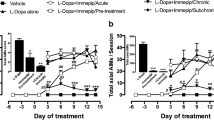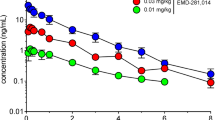Abstract
Rationale
We have shown that the 5-HT1A agonist R-(+)-hydroxy-2-(di-n-propylamino)tetralin [R-(+)-8-OHDPAT] enhances motor activity in the monoamine-depleted rat, an acute model of Parkinson’s disease. The present work extends these findings by investigating motor effects of R-(+)-8-OHDPAT in the unilateral 6-hydroxydopamine-lesioned rat, a chronic model of Parkinson’s disease.
Objective
The objectives of the present study were to assess the motor response to R-(+)-8-OHDPAT in rats with unilateral destruction of the nigrostriatal dopamine system and to determine the involvement of postsynaptic 5-HT1A receptors in this response.
Materials and methods
Rotational behavior after R-(+)-8-OHDPAT was investigated in rats that received 6-hydroxydopamine unilaterally into the median forebrain bundle 2 weeks before testing.
Results
A dose of 0.3 mg/kg subcutaneously (s.c.) R-(+)-8-OHDPAT induced significant ipsilateral turning in unilateral 6-OHDA-lesioned rats. Pretreatment with the selective 5-HT1A antagonist N-[2-[4-(2-methoxyphenyl)-1-piperazinyl]ethyl]-N-2-pyridinyl-cyclohexanecarboxiamide maleate (WAY-100635, 0.1 mg/kg, s.c.) blocked turning. Blockade of 5-HT synthesis and 5-HT depletion caused by the tryptophan hydroxylase inhibitor dl-p-chlorophenylalanine did not decrease R-(+)-8-OHDPAT-induced turning. Finally, a subset of animals were tested for their turning response to the dopamine agonist apomorphine after tests with R-(+)-8-OHDPAT had been completed. Correlation analysis indicated no relationship existed between the turning response to apomorphine and the turning response to R-(+)-8-OHDPAT.
Conclusion
R-(+)-8-OHDPAT induces ipsilateral turning in unilateral 6-OHDA lesioned rats by stimulating postsynaptic 5-HT1A receptors, not by altering 5-HT synthesis and release. The mechanism underlying the motor effects of R-(+)-8-OHDPAT appears to differ from classic dopaminergic anti-parkinsonian agents suggesting that 5-HT1A agonists might prove useful adjunctive therapy in the treatment of Parkinson’s disease.





Similar content being viewed by others
References
Ahlenius S, Salmi P (1995) Antagonism of reserpine-induced suppression of spontaneous motor activity by stimulation of 5-HT1A receptors in rats. Pharmacol Toxicol 76:149–156
Ahlenius S, Hillegaart V, Salmi P, Wijkstrom A (1993) Effects of 5-HT1A receptor agonists on patterns of rat motor activity in relation to effects on forebrain monoamine synthesis. Pharmacol Toxicol 72:398–406
Ahlenius S, Henriksson I, Magnusson O, Salmi P (1999) In vivo efficacy of the 5-HT1A receptor antagonists NAD-299, WAY-100,635 and (S)-(−)-UH-301 at rat brain monamine receptors. Eur Neuropsychopharmacol 9:15–19
Albert PR, Lemonde S (2004) 5-HT1A receptors, gene repression, and depression: guilt by association. Neuroscientist 10(6):575–593
Andersen HL, Kilpatrick IC (1996) Prevention by (+/−)-8-hydroxy-2-(di-n-propylamino)tetralin of both catalepsy and the rises in rat striatal dopamine metabolism caused by haloperidol. Br J Pharmacol 118(2):421–427
Araneda R, Andrade R (1991) 5-Hydroxytryptamine2 and 5-hydroxytryptamine1A receptors mediate opposing responses on membrane excitability in rat association cortex. Neuroscience 40:399–412
Aznar S, Qian Z, Shah R, Rahbek B, Knudsen GM (2003) The 5-HT1A serotonin receptor is located on calbindin- and parvalbumin-containing neurons in the rat brain. Brain Res 959(1):58–67
Bara-Jimenez W, Bibbiani F, Morris MJ, Dimitrova T, Sherzai A, Mouradian MM, Chase TN (2005) Effects of serotonin 5-HT1A agonist in advanced Parkinson’s disease. Mov Disord 20:932–936
Bellomo M, Giuffrida R, Palmeri A, Sapienza S (1998) Excitatory amino acids as neurotransmitters of corticostriatal projections: immunocytochemical evidence in the rat. Arch Ital Biol 136:215–223
Bishop C, Taylor JL, Kuhn DM, Eskow KL, Park JY, Walker PD (2006) MDMA and fenfluramine reduce l-DOPA-induced dyskinesia via indirect 5-HT1A receptor stimulation. Eur J Neurosci 23:2669–2676
Boldry RC, Chase TN, Engber TM (1993) Influence of previous exposure to levodopa on the interaction between dizocilpine and dopamine D1 and D2 agonists in rats with 6-hydroxydopamine-induced lesions. J Pharmacol Exp Ther 267:1454–1459
Brotchie JM, Mitchell IJ, Sambrook MA, Crossman AR (1991) Alleviation of parkinsonism by antagonism of excitatory amino acid transmission in the medial segment of the globus pallidus in rat and primate. Mov Disord 6:133–138
Cadet JL, Zhu SM (1992) The intrastriatal 6-hydroxydopamine model of hemiparkinsonism: quantitative receptor autoradiographic evidence of correlation between circling behavior and presynaptic as well as postsynaptic nigrostriatal markers in the rat. Brain Res 595:316–326
Chase TN, Oh JD, Blanchet PJ (1998) Neostriatal mechanisms in Parkinson’s disease. Neurology 51(2 Suppl 2):S30–S35
Chemel BR, Roth BL, Armbruster B, Watts VJ, Nichols DE (2006) WAY-100635 is a potent dopamine D4 receptor agonist. Psychopharmacology (Berl) 188:244–251
Chen HS, Lipton SA (2006) The chemical biology of clinically tolerated NMDA receptor antagonists. J Neurochem 97:1611–1626
Di Chiara G, Morelli M, Barone P, Pontieri F (1992) Priming as a model of behavioural sensitization. Dev Pharmacol Ther 18(3–4):223–227
Dijk SN, Francis PT, Stratman GC, Bowen DM (1995) NMDA-induced glutamate and aspartate release from rat cortical pyramidal neurones: evidence for modulation by a 5-HT1A antagonist. Br J Pharmacol 115:1169–1174
Dray A, Gonye TJ, Oakley NR, Tanner T (1976) Evidence for the existence of a raphe projection to the substantia nigra in the rat. Brain Res 113:45–57
Feighner JP, Merideth CH, Hendrickson GA (1982) A double-blind comparison of buspirone and diazepam in outpatients with generalized anxiety disorder. J Clin Psychiatry 43:103–108
Francis PT, Pangalos MN, Pearson RCA, Middlemiss DN, Stratmann GC, Bowen DM (1992) 5-Hydroxytryptamine1A but not 5-hydroxytryptamine2 receptors are enriched on neocortical pyramidal neurones destroyed by intrastriatal volkensin. J Pharmacol Exp Ther 261(3):1273–1281
Gerber R, Altar CA, Liebman JM (1988) Rotational behavior induced by 8-hydroxy-DPAT, a putative 5-HT1A agonist, in 6-hydroxydopamine-lesioned rat. Psychopharmacology (Berl) 94:178–182
Henry B, Crossman AR, Brotchie JM (1998) Characterization of enhanced behavioral responses to L-DOPA following repeated administration in the 6-hydroxydopamine-lesioned rat model of Parkinson’s disease. Exp Neurol 151(2):334–342
Hudson JL, Van Horne CG, Strömberg I, Brock S, Clayton J, Masserano J, Hoffer BJ, Gerhardt GA (1993) Correlation of apomorphine- and amphetamine-induced turning with nigrostriatal dopamine content in unilateral 6-hydroxydopamine lesioned rats. Brain Res 626:167–174
Johansson L, Sohn D, Thorberg S-O, Jackson DM, Kelder D, Larsson L-G, Renyi L, Ross SB, Wallsten C, Eriksson H, Hu P-S, Jerning E, Mohell N, Westlind-Danielsson A (1997) The pharmacological characterization of a novel selective 5-hydroxytryptamine1A receptor antagonist, NAD-299. J Pharmacol Exp Ther 283:216–225
Kia HK, Miquel M-C, Brisorgueil M-J, Daval G, Riad M, El Mestikawy S, Hamon M, Verge D (1996) Immunocytochemical localization of serotonin1A receptors in the rat central nervous system. J Comp Neurol 365:289–305
Kuhn DM, Wolf WA, Youdim MBH (1985) 5-Hydroxytryptamine release in vivo from a cytoplasmic pool: studies on the behavioural syndrome in reserpinized rats. Br J Pharmacol 84:121–129
Lejeune F, Newman-Tanceri A, Audinot V, Millan MJ (1997) Interactions of (+)- and (−)-8- and 7-hydroxy-2-(Di-n-Propylamino)tertralin at human (h)D3, hD2 and h serotonin1A receptors and their modulation of the activity of serotonergic and dopaminergic neurones in rats. J Pharmacol Exp Ther 280:1241–1249
Lu JQ, Nagayama H (1996) Circadian rhythm in the response of central 5-HT1A receptors to 8-OH-DPAT in rats. Psychopharmacology (Berl) 123:42–45
Marino MJ, Valenti O, Conn PJ (2003) Glutamate receptors and Parkinson’s disease: opportunities for intervention. Drugs Aging 20:377–397
Matsubara K, Shimizu K, Suno M, Ogawa K, Awaya T, Yamada T, Noda T, Satomi M, Ohtaki K, Chiba K, Tasaki Y, Shiono H (2006) Tandospirone, a 5-HT1A agonist, ameliorates movement disorder via non-dopaminergic systems in rats with unilateral 6-hydroxydopamine-generated lesions. Brain Res 1112:126–133
Mignon L, Wolf WA (2002) Postsynaptic 5-HT1A receptors mediate an increase in locomotor activity in the monoamine-depleted rat. Psychopharmacology (Berl) 163:85–94
Mignon L, Wolf WA (2005) 8-hydroxy-2-(di-n-propylamino)tetralin reduces striatal glutamate in an animal model of Parkinson’s disease. Neuroreport 16(7):699–703
Morelli M, Fenu S, Garau L, Di Chiara G (1989) Time and dose dependence of ‘priming’ of the expression of dopamine receptor supersensitivity. Eur J Pharmacol 162:329–355
Morelli M, Fenu S, Pinna A, Di Chiara G (1992) Opposite effects of NMDA receptor blockade on dopamine D1- and D2-mediated behavior in the 6-hydroxydopamine model of turning: relationship with c-fos expression. J Pharmacol Exp Ther 260:402–408
Nathan PJ, Burrows GD, Norman TR (1998) Evidence for 5-HT1A receptor control of pineal melatonin concentrations in the rat. Eur Neuropsychopharmacol 8:183–186
Neal-Beliveau BS, Joyce JN, Lucki I (1993) Serotonergic involvement in haloperidol-induced catalepsy. J Pharmacol Exp Ther 265:207–217
Nutt JG (1990) Levodopa-induced dyskinesia. Neurology 40:340–345
Olanow CW, Damier P, Goetz CG, Mueller T, Nutt J, Rascol O, Serbanescu A, Deckers F, Russ H (2004) Multicenter, open-label, trial of sarizotan in Parkinson disease patients with levodopa-induced dyskinesias (the SPLENDID study). Clin Neuropharmacol 27:58–62
Olds ME, Jacques DB, Kopyov O (2006) Relation between rotation in the 6-OHDA lesioned rat and dopamine loss in striatal and substantia nigra subregions. Synapse 59:532–544
Paxinos G, Watson C (1998) The rat brain in stereotaxic coordinates, 4th edn. Academic, Sydney
Pompeiano M, Palacios JM, Mengod G (1992) Distribution and cellular localization of mRNA coding for 5-HT1A receptor in the rat brain: correlation with receptor binding. J Neurosci 12:440–453
Prisco S, Pagannone S, Esposito E (1994) Serotonin-dopamine interaction in the ventral tegmental area: an electrophysiological study in vivo. J Pharmacol Exp Ther 271:83–90
Riad M, Garcia S, Watkins KC, Jodoin N, Doucet E, Langlois X, el Mestikawy S, Hamon M, Descarries L (2000) Somatodendritic localization of 5-HT1A and preterminal axonal localization of 5-HT1B serotonin receptors in adult rat brain. J Comp Neurol 417(2):181–194
Robinson DS, Sitsen JM, Gibertini M (2003) A review of the efficacy and tolerability of immediate-release and extended-release formulations of gepirone. Clin Ther 25:1618–1633
Schwarting RKW, Huston JP (1996) The unilateral 6-hydroxydopamine lesion model in behavioral brain research. Analysis of functional deficits, recovery and treatments. Prog Neurobiol 50:275–331
Schwarting RKW, Bonatz AE, Carey RJ, Huston JP (1991) Relationships between indices of behavioral asymmetries and neurochemical changes following mesencephalic 6-hydroxydopamine injections. Brain Res 554:46–55
Sharp T, Bramwell SR, Grahame-Smith DG (1989) 5-HT1 agonists reduce 5-hydroxytryptamine release in rat hippocampus in vivo as determined by brain microdialysis. Br J Pharmacol 96:283–290
Sotelo C, Cholley B, El Mestikawy S, Gozlan H, Hamon M (1990) Direct immunohistochemical evidence of the existence of 5-ht1a autoreceptors on serotoninergic neurons in the midbrain raphe nuclei. Eur J Neurosci 2(12):1144–1154
Ungerstedt U, Arbuthnott GW (1970) Quantitative recording of rotational behavior in rats after 6-hydroxy-dopamine lesiones of the nigrostriatal system. Brain Res 24:485–493
Wadenberg MLG, Young KA, Richter JT, Hicks PB (1999) Effects of local application of 5-hydroxytryptamine into the dorsal or median raphe nuclei on haloperidol-induced catalepsy in the rat. Neuropharmacology 38:151–156
Wolf WA (2003a) DU-127090 Solvay/H Lundbeck. Curr Opin Investig Drugs 4(1):72–76
Wolf WA (2003b) SLV-308 Solvay. Curr Opin Investig Drugs 4(7):878–882
Wolf WA, Bobik A (1989) alpha-Methyldopa metabolism in central serotonergic nerve terminals: effects on serotonin levels, synthesis and release. Eur J Pharmacol 163:43–53
Wright DE, Seroogy KB, Lundgren KH, Davis BM, Jennes L (1995) Comparative localization of serotonin1A, 1C, and 2 receptor subtype mRNAs in rat brain. J Comp Neurol 351:357–373
Acknowledgment
This work was supported by a Merit Award (WAW) from the Department of Veteran’s Affairs and by PHS grant NS 36410 (WAW.). This research represents work carried out in partial fulfillment of the requirements for the degree of Doctor of Philosophy (LM).
Author information
Authors and Affiliations
Corresponding author
Rights and permissions
About this article
Cite this article
Mignon, L., Wolf, W.A. Postsynaptic 5-HT1A receptor stimulation increases motor activity in the 6-hydroxydopamine-lesioned rat: implications for treating Parkinson’s disease. Psychopharmacology 192, 49–59 (2007). https://doi.org/10.1007/s00213-006-0680-0
Received:
Accepted:
Published:
Issue Date:
DOI: https://doi.org/10.1007/s00213-006-0680-0




